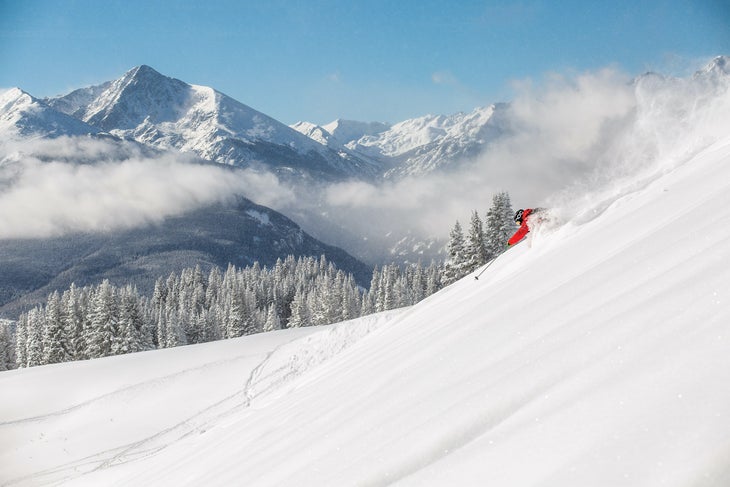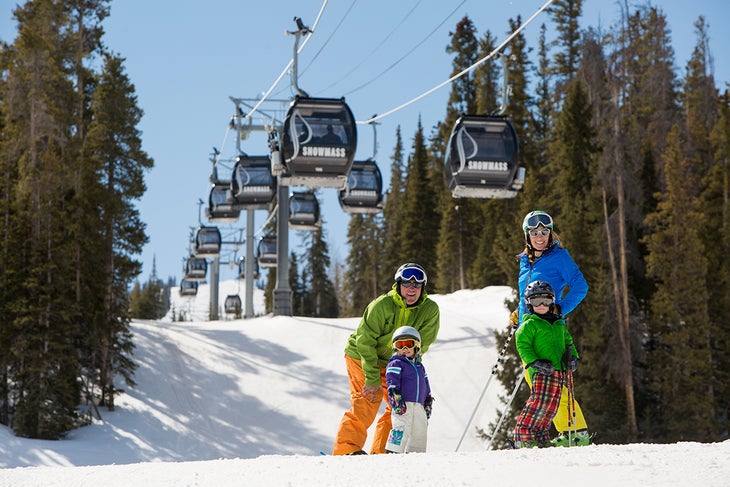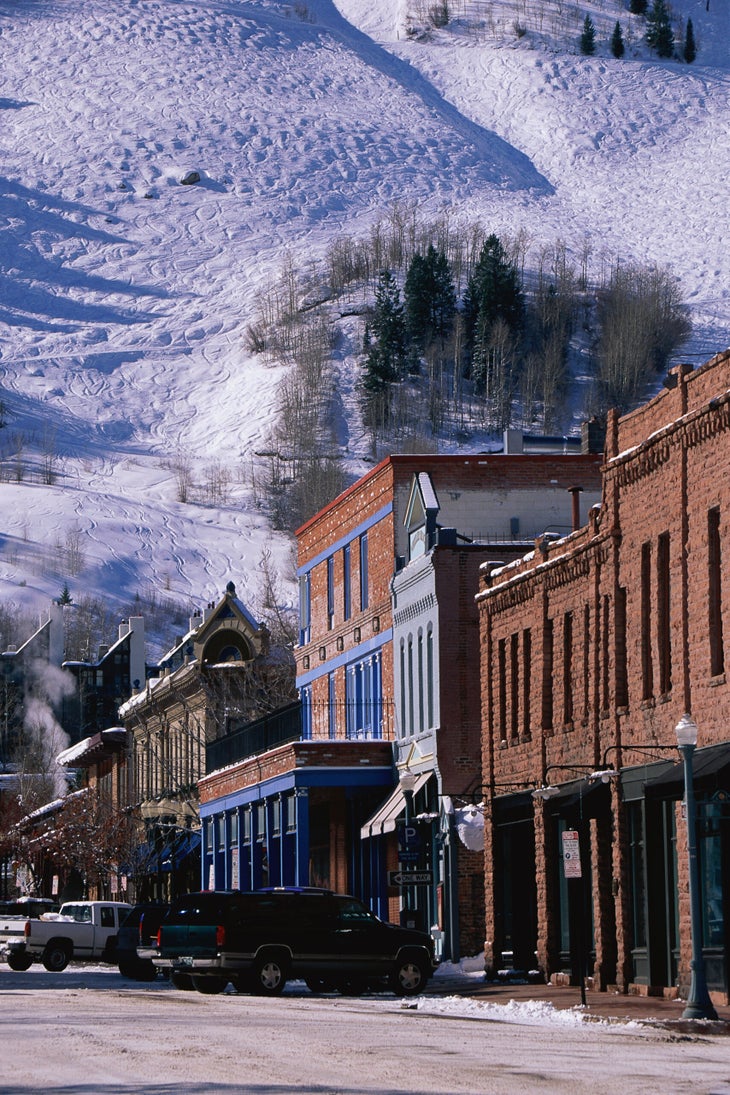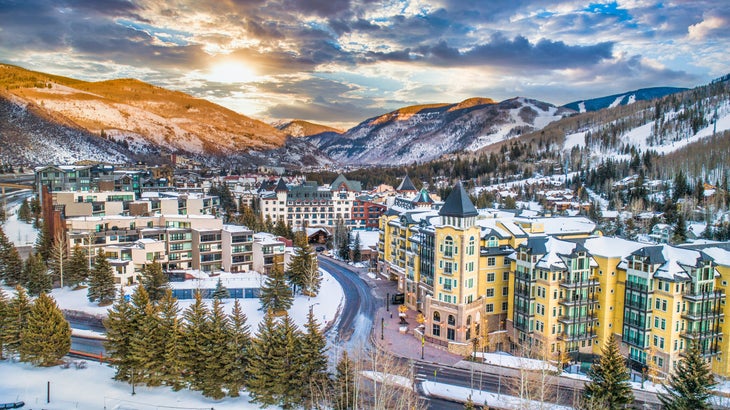

Photo: Courtesy of Aspen Skiing Co./Vail Resorts
Heading out the door? Read this article on the new Outside+ app available now on iOS devices for members! >","name":"in-content-cta","type":"link">>'>Download the app.
Colorado’s two superstar resorts collectively lure millions of skiers to their slopes each season, but the two couldn’t be more different when it comes to the vacation experience you’ll have at each resort. Here, we break down some of the key differences to help you make a decision on which one is best for you.
Hugely varied terrain and something for all levels of skiers are two things that Vail Mountain and Aspen Snowmass have in common. The main difference is in the layout of the resorts. Vail Mountain’s slopes are all interconnected across its over 5,000 skiable acres, whereas Aspen Snowmass comprises four separate resorts, and you have to drive or shuttle between them.
Vail Mountain, the flagship resort of the entire Vail Resorts operation, is massive: 5,280 skiable acres that spans across five miles. Accessed from three main villages—Vail Village, Lionshead, Golden Peak—the slopes are varied and robust. From gentle beginner terrain off Golden Peak to the legendary Back Bowls, the cliched “something for everyone” really does apply here.

While true beginners would be well-served to start their ski careers at smaller, community-based mountains that are easier to navigate (and less expensive), just under 20 percent of Vail’s terrain is green. Once your ski legs are under you and you can safely ride a lift, some of the best, more scenic and winding green runs can be found on Eagle’s Nest Ridge, or the Avanti or Wildwood chairs.
For intermediates, Vail is a great mountain to test yourself and level up. From the Lionshead base village, make your way to Born Free and Simba, off of the Eagle Bahn Gondola. Another blue-run favorite is Game Creek Bowl; Showboat and The Woods are a blast. The Northwoods Express, while mostly serving expert terrain, is also home to the wide-open groomer Northwoods, which is not to be missed.
Strong intermediates looking for a challenge shouldn’t shy away from the Back Bowls; there are a handful of groomed runs designed to let skiers of varying skill levels safely get a taste of what it feels like to ski in the backcountry. While the ungroomed “runs” are rated black technically, China Bowl and Sun Up Bowl are totally doable for confident intermediates not afraid of a little variable snow—or powder!
Experts and beyond can really go anywhere at Vail, from the steeper frontside terrain—including Prima and Riva Ridge off Northwoods and double-black Highline off the Highline chair—to the bowls. On the backside, while the majority of the terrain is rated black, there’s little super-difficult stuff back there. Our favorite trails for experts are the sustained vertical of China Bowl’s Ghengis Khan and Siberia Bowl’s Orient Express. Sun Down Bowl is a lock for experts, especially Morningside Ridge and Ricky’s Ridge.
The famed Blue Sky Basin is a must for adventurous intermediate and experts for the views and the backcountry feel. Intermediate can stick to the mellowers pitches of Pete’s Bowl while those looking for challenge with their views will find them both off the Skyline Express off Steep and Deep and Lover’s Leap.
Aspen Snowmass’s four separate resorts each serve up entirely different ski experiences. Depending on what you’re after during your vacation, this is either a great thing or an inconvenience. We’ll run through the pros and cons below.
The four resorts are Aspen Mountain (known locally as Ajax) which rises from the town of Aspen itself; Snowmass, the sprawling, 3,000-acres mountain about 10 miles outside of Aspen, the beginner’s hill Buttermilk, and Aspen Highlands, best for experts and known for its hike-to Highland Bowl.
Ajax is small (less than 700 skiable acres) and steep. It’s a ski-anything-you-can-see type of place that’s really geared toward adventurous experts looking for glades and steep pitches not readily visible from the lifts. There’s no beginner terrain here, but you can right down into Aspen and party like the ski bum you always dreamed of being.

Snowmass is the “resort” mountain, or the place most skiers would consider the mainstream ski destination of the four mountains. And with 3,339 acres, skiers of all abilities will find what they need at Snowmass. There’s more than enough of all types of terrain to keep skiers busy for a week without even having to visit any of the other mountains. Despite the fact that Buttermilk is considered the beginner mountain, Snowmass has enough green terrain, plus excellent ski schools for both kids and adults, for never-evers, but it’s big and can be overwhelming to navigate. Snowmass’s sweet spot is intermediates, from the scenic groomers off the Elk Camp chair—Long Shot is five magnificent miles—to the Alpine Spring chair’s Slider and Naked Lady runs. Experts should be sure not to miss the bumps of Sam’s Knob and the steep trees off the Big Burn chair—we love Sneaky’s Glades.
Most Aspen Snowmass visits skip Buttermilk—it’s 35 percent green terrain—but this is a stellar spot for first-timers to get their ski legs under them in a smaller, less-intimidating environment. Aside from that, this is home to X Games, so the terrain parks alone are worth checking out if that’s your jam. A two-mile trail wends down from the summit with different park pods along the way—it’s a blast for jibbers and kids who like to dabble on the different sized rails, box, berms, kickers, and jumps.
Aspen Highlands is an absolutely must for experts. Not just because of the legendary Highland Bowl—which you don’t have to hike, but really should—but rather because this sleeper has some of the best, steepest, big-mountain skiing in Colorado. Highlands is why skilled skiers choose an Aspen Snowmass vacation, and they aren’t disappointed. Off of the Deep Temerity lift, Steeplechase (bumps) and Canopy Cruiser (glades) are some of the toughest runs on the mountain. Highland bowl is the cherry on top of the whole experience. It’s a 250-acres open bowl; to reach the summit it’s a 800-vertical-foot hike. It’s all in-bounds and patrolled, no avy gear needed, and truly provided a backcountry-like experience without the risk.
Bottom Line : Both resorts serve up well-rounded ski experiences for all levels, but adventurous intermediates will find bottomless opportunities for challenges and opportunities to level up a Vail, while Aspen Snowmass’s strengths lend themselves more to experts at Ajax and Aspen Highlands.
You won’t go homeless or hungry at either Vail or Aspen Snowmass, but there are some key differences, especially when it comes to ski-in/ski-out lodging (very little at Vail or in the town of Aspen, plenty at Snowmass) and the overall character of the towns.

Even saying “towns” is a bit of a misnomer; Aspen is the only true town—a former mining town built up by silver miners in the late 1800s. The rich history is infused into the original storefronts and hotel facades. Lodging options like the Hotel Jerome, built in the 1880s, offers a mix of luxury and character throughout the historic property.
The lodgings options at Snowmass are far more traditional “ski resort,” with sprawling resort hotels such as the Viceroy and the Viewline Resort Snowmass , formerly the Westin Snowmass, offering up all the modern conveniences, if less of the character. Snowmass has built up its base village quite a bit over the last handful of years, so there’s now more lodging and amenities than ever, including the Limelight Snowmass , complete with its own climbing wall and hoppin’ vibe. Snowmass also has the only true ski-in/ski-out lodging options of the four resorts, including oodles of on-mountain condos, if that’s something that’s important to you. There’s no lodging at the base of Buttermilk, and just a single hotel, a Ritz-Carlton Club, at the Highlands base.
Vail came up in the 1960s, modeled after the Bavarian villages of the Alps. It’s one of the first of the “purpose-built” ski villages that have subsequently popped up across ski country over the years, and what it lacks in authenticity it makes up for in the breadth of amenities and options. Resort hotels such as the Four Seasons Vail and Arrabelle at Vail Square , boutique hotels like the Sonnenalp, and budget options such as Evergreen Lodge are all accounted for, plus many more. There’s very little ski-in/ski-out lodging here due to the design of the village and the relatively little real estate between the slopes and the interstate, but there are plenty of hotels that are within a few minute’s walk to the lifts.

As far as where to stay at Vail, village-wise, Vail Village is the main village, home to most of the restaurants, nightlife, shopping, and hustle and bustle. Lionshead is a 15-minute walk or quick shuttle, and is a little quieter and more quaint, but still has enough amenities to keep travelers well fed and satisfied.
Bottom Line : Snowmass and Vail offer the traditional “ski resort” experience when it comes to off-slope amenities, but the town of Aspen has way more character and charm.
Both Aspen and Vail can be reached from Denver International Airport in about a 3.5- and 2-hour drive respectively. Each resort also has a smaller, closer airport that’s not as well-served by as many airlines but cuts the drive down considerably if you can score a reasonable flight
Vail Eagle County Airport is 35 miles from Vail and offers a surprisingly robust winter service for such a small airport. Over a dozen U.S. cities are served by nonstop flights—Philadelphia, N.Y., Chicago, and L.A,, to name a few big ones. Prices tend to be higher than at DIA, but you could recoup the savings in ground transportation costs.
Aspen’s closest airport is Aspen/Pitkin County Airport , 4 miles from the town of Aspen and 6 from Snowmass. The small airport is served by two airlines—United and American—that offer nonstop service from 10 U.S. cities in the winter, including San Francisco, Atlanta, and, new last winter, Phoenix.
Bottom Line: Vail is the easier trip. It’s closer to DIA, and its regional airport offers more flights. That also means it’s likely to be more crowded. Regardless, y ou don’t need a car at either resort considering shuttles serve the airports and run between the resorts and various base villages.
Both resorts are on a multipasses—Vail on the Epic Pass and Aspen Snowmass on the Ikon Pass . The major difference is that Vail access is unrestricted on the full Epic Pass while skiers only get seven days at the Aspen Snowmass resorts on the full Ikon Pass.
Once you drop down to the second tier of each pass, it gets even more restrictive at these two resorts. On the Epic Local pass, skiers get 10 days to split between Vail and neighboring Beaver Creek. Ikon Base Pass holders need to buy the Ikon Base Plus pass for an additional $200 to get five days at Aspen Snowmass (and a handful of other resorts including Jackson Hole and Deer Valley).

Aspen is also on the Mountain Collective . Pass holders get two days there, with the option to add a third day, plus 50 percent off additional lift tickets.
Bottom Line : At $859 for a full Epic Pass vs. $1,179 for a full Ikon Pass with only seven days between the four Aspen Snowmass mountains, Vail is clearly the better value option. Again, it’s also likely to be more crowded, although Vail is limiting daily lift tickets all winter.
There are entire travel guidebooks dedicated to parsing out the details of all that these resorts have to offer, so it’s hard to even scratch the surface in the space we have here. But at the end of the day, two resorts’ differences do lead to very distinct experiences at each one. You’ll find skiers who swear by one and visit every season, and some who like to bounce around because they like the variety.
In our opinion, Vail offers an easier ski vacation experience simply due to everything being in one place. There’s certainly enough varied terrain to keep most skiers engaged—although experts might get a little bored—and more than enough off the slopes to satisfy every taste, both in dining and lodging.
Aspen Snowmass, however, edges out Vail when it comes to true expert terrain, and the town of Aspen, with its deep history and Colorado character, simply has few equals. If you’re okay having to shuttle between mountains, a vacation here will check all the boxes from skiing to lodging to nightlife and beyond.

Samantha Berman is SKI’s travel and resorts editor. Since joining the editorial team in 2003, Sam has helped mold the direction of the brand’s travel coverage, sharing her years of experience visiting ski resorts and mountain towns across North America, the Alps, and beyond. Growing up in an East Coast ski family, Sam cherished family time with her mother, father, and two brothers at resorts in New York and Vermont, and has successfully passed her love of the…